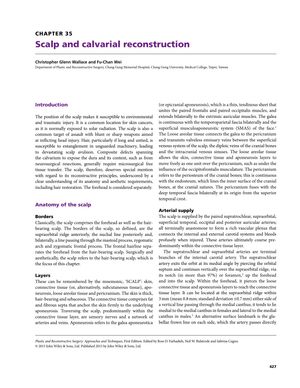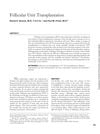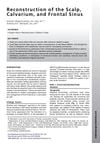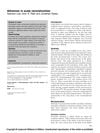Scalp and Calvarial Reconstruction
March 2015
scalp reconstruction calvarial reconstruction secondary healing primary closure skin grafting local flaps rotation flaps transposition flaps tissue expansion free tissue transfer hair restoration follicular unit transplantation hair follicle cloning scalp vascularized composite allotransplantations immunosuppression scalp VCAs

TLDR The conclusion is that closing scalp wounds is possible, but restoring hair without donor material is still a major challenge.
The document from 2015 provides an extensive review of scalp and calvarial reconstruction, detailing the anatomy and wound healing capabilities of the scalp, which can often heal without surgery due to its rich blood supply. It outlines various reconstruction techniques, including secondary healing, primary closure, skin grafting, and local flaps, with a focus on achieving aesthetically pleasing results with hair growth. For defects up to 5-6 cm, rotation and transposition scalp flaps are recommended, and tissue expansion is highlighted for replacing like tissue. Free tissue transfer is suggested for larger or unhealthy defects, though it may not match the original hair density. The document also discusses advances in hair restoration, particularly follicular unit transplantation, which offers a more natural appearance compared to traditional methods. However, it notes the challenge of hair restoration when no donor material is available, with hair follicle cloning being disappointing and scalp vascularized composite allotransplantations (VCAs) being limited due to immunosuppression risks. The conclusion emphasizes that while wound closure is achievable for total scalp defects, hair restoration without donor material remains a significant challenge.




